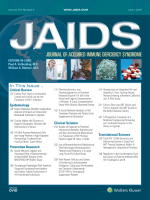Posted on September 01, 2017
Source: JAIDS Journal of Acquired Immune Deficiency Syndromes

How Do Social Capital and HIV/AIDS Outcomes Geographically Cluster and Which Sociocontextual Mechanisms Predict Differences Across Clusters?
Ransome Y, Dean LT, Crawford ND, Metzger DS, Blank MB, Nunn AS
BACKGROUND:
Place of residence has been associated with HIV transmission risks. Social capital, defined as features of social organization that improve efficiency of society by facilitating coordinated actions, often varies by neighborhood, and hypothesized to have protective effects on HIV care continuum outcomes. We examined whether the association between social capital and 2 HIV care continuum outcomes clustered geographically and whether sociocontextual mechanisms predict differences across clusters.
METHODS:
Bivariate Local Moran's I evaluated geographical clustering in the association between social capital (participation in civic and social organizations, 2006, 2008, 2010) and [5-year (2007-2011) prevalence of late HIV diagnosis and linkage to HIV care] across Philadelphia, PA, census tracts (N = 378). Maps documented the clusters and multinomial regression assessed which sociocontextual mechanisms (eg, racial composition) predict differences across clusters.
RESULTS:
We identified 4 significant clusters (high social capital-high HIV/AIDS, low social capital-low HIV/AIDS, low social capital-high HIV/AIDS, and high social capital-low HIV/AIDS). Moran's I between social capital and late HIV diagnosis was (I = 0.19, z = 9.54, P < 0.001) and linkage to HIV care (I = 0.06, z = 3.274, P = 0.002). In multivariable analysis, median household income predicted differences across clusters, particularly where social capital was lowest and HIV burden the highest, compared with clusters with high social capital and lowest HIV burden.
DISCUSSION:
The association between social participation and HIV care continuum outcomes cluster geographically in Philadelphia, PA. HIV prevention interventions should account for this phenomenon. Reducing geographic disparities will require interventions tailored to each continuum step and that address socioeconomic factors such as neighborhood median income.